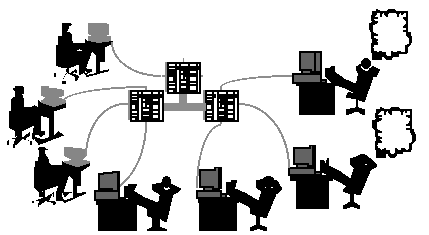
| Junichi Shimada Managing Director, Real World Computing Partnership Director, RWCP Research Institute |

| Junichi Shimada Managing Director, Real World Computing Partnership Director, RWCP Research Institute |
The needs for computing power in large research institutions and special offices are more demanding year by year. But then, small laboratories and general offices may need more than word processors, eventually they will wish to use supercomputers as well. That is what history proves. However, installing a supercomputer requires not only money but also the space to accommodate it, and more powerful air-conditioning. Small laboratories and general offices may not afford these additional costs.
In such workplaces, nevertheless, many PCs and workstations are used, for sure. The power of each computer may be small but should be large when combined together. Such combined power might compare with a supercomputer. However, no keyboard is incessantly hit, meaning those computers are idle most of the time. In other words, the potential power of a supercomputer is wasted. Hence, even small offices can get the power of a supercomputer by interconnecting their PCs and workstations and making full use of the time they lie idle. Therefore, after two years of conception around the Tsukuba Research Center, a seamless computing development plan has been chosen as the core of this project for the second half period. I will describe the plan below.
How could we accomplish this? First of all, computers must be able to communicate with one another. For this, invocation operations such as "rlogin..." must be eliminated. That is, computers must be interconnected without a seam. This brought an idea of "seamless computing."
Next, processors and memories on remote machines must appear as if they were on a personal machine. For instance, we must be able to read from and write in memories on remote machines. Not only that, access speed should be unchanged. For this, the cabling among computers must have the same throughput as that within a computer. Fortunately, optical communication technology has become available to computers.
This is also important to note, even in a single workplace, all the people may not use computers with the same architecture. Also, some may upgrade to a new model when it appears on the market. In addition, newly hired people may increase the number of computers. Thus, we must develop software to overcome the difference in architectures and which is also adaptive to an increased number of machines. A mechanism to accommodate the difference in data formats is also required.
How can we achieve the power of a supercomputer by interconnecting PCs? Actual "supercomputers" need special processors, so interconnecting PCs will not yield a real supercomputer. Combining small-scale processors naturally leads to a "parallel computer." The result is a seamless computer system. So, a seamless computer system is a system where various computers placed on individual desks, and usually used independently, form a parallel computer when needed.
In short, the goals of this plan is to make parallel systems available to even small groups one way or another, encourage the development of parallel programs, and then pioneer a new age of "office supercomputing."

We are striving to make this a Japan-originated trend.